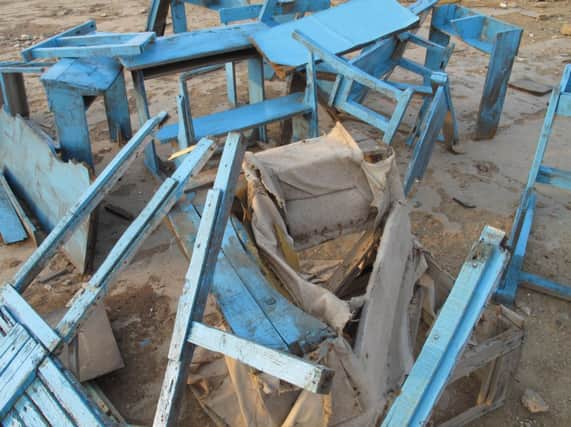Visual art: Naiza Khan | Thomson & Craighead


Naiza Khan: Disrupting The Alignment
Cooper Gallery, Dundee
Rating: * * *
A 20-minute ferry ride from the Pakistani port of Karachi is Manora Island. Once a naval base and a thriving fishing community, Manora is now an anomaly. It’s a beach resort, with no real tourist infrastructure and waters a little too grimy to be considered completely safe. Its concrete buildings are unfinished or simply crumbling. Pakistan’s navy has now moved 250km away. Manora, once home to some 3,000 people, has been rendered almost silent by the draw of the nearby city of some 20 million.
It’s also a rich place of inspiration for the artist Naiza Khan, whose debut Scottish show has just opened at the Cooper Gallery at Duncan of Jordanstone College of Art in Dundee. Khan, who studied at the Ruskin in Oxford, but has lived in Karachi and championed its nascent contemporary art scene for many years, has visited the island frequently.
Advertisement
Hide AdVisitors often go to Manora for the refreshing breezes on the boat across. The island has become a place for the artist to reflect on the winds of change in her country, be they the more recent blasts of globalisation and urbanisation or the historic whirlwinds of de-colonisation. In a tragic sequence, recorded for a film entitled Homage, the artist comes across an abandoned school where four young children were killed by the collapse of a crumbing wall. Patiently she paints the wooden wreckage of school desks and chairs pale blue. It is the colour of the tombs in the local graveyard.
Khan’s film Observatory is a short tour around a crumbling observatory on the island; its yellow painted walls are crumbling to reveal the stone beneath. Inside the place is damp and disordered, but the bookshelves are still full of the abandoned logbooks of the Karachi Port Authority. It is from one of these books, the India Weather Review, that a narrator reads a series of weather reports from 1939. The weather is catastrophic, “Damage to crops, hundreds of birds killed.” “One dead, 12 head of cattle killed.”
These are powerful metaphors for historical forces we cannot control. But as the narrator reels off place names like Bengal and Darjeeling, it is also a reminder of a colonial India before Pakistan took shape. Countries, cities, certainties, there aren’t any fixed points. Like the elegant watercolours of floating buildings that Khan also shows, history can leave us peculiarly unanchored. Karachi is huge, ever-growing, but subject too to the winds of change. It was once the capital of Pakistan, now that is Islamabad.
Thomson & Craighead: Maps, Dna And Spam
Dundee Contemporary Arts
Rating: * * *
At Dundee Contemporary Arts, Jon Thomson and Alison Craighead who met at art college in Dundee also take the global/local conundrum as the starting point of their major exhibition of new and recent work. Maps DNA and Spam is a rare exhibition that combines the view from a bedroom window in Lochgelly, Fife, with footage from Rwanda and the Baghram Air Base in Afghanistan.
All of the work on show is culled from existing sources, from blogs and photo-sharing sites, from old movies and new computer viruses. Much of the duo’s work asks what happens when you change, not information itself but the way in which it is communicated. A vast wall of primitive typeset posters, for example, is actually a selection of recent tweets. Dundee Wall reveals what the folk of Dundee are doing and thinking and posting on Twitter. Their obsessions seem simple: there’s a lot of talk of pizza, football and a fair number of insults to Arbroath. Occasionally, though, emotions break through: like this forlorn tweet: “It’s annoying how you can still feel shit when you have everything you want.”
Thomson and Craighead, who live between London where they teach and a home on Speyside, have everything they want at the touch of a button: they take the world of the internet as both their subject and their methodology. Sometimes it is a matter of simply tweaking existing artefacts to their own devices. The Time Machine in Alphabetical Order, like Christian Marclay’s epic The Clock, takes classic celluloid material and carefully reshapes it for the computer age. This time it is the 1960 film of HG Wells’s The Time Machine. But if the methodology is the same, Thomson and Craighead take the principle to absurdity.
Advertisement
Hide AdRecasting the words of the film in alphabetical order renders its narrative completely unreadable, but I like the melancholic sequence in which the word “paradise” is rapidly followed by the word “past”.
Watching a new film The First Person, which combines text from self-help websites with insurance footage of a house in flames, one thinks of many precedents. For example, there is the dramatic imagery of Andrei Tarkovsky’s late film The Sacrifice, itself a tribute to the anxious images of domestic fires in Munch’s paintings. Or Janet Cardiff and George Bures Miller’s 2001 film, House Burning, where the artists themselves arranged to burn a house to the ground.
Advertisement
Hide AdIn Thomson and Craighead’s hands it’s not clear whether they present these dramatic images as symptomatic of a new condition of anxiety in the internet age or as an example of an eternal and existential problem.
The film itself is certainly eternal in that it’s an endless stream of randomly cut information, which will continue to generate new combinations. At their best, the artists manage artfully to combine the technological with the poetic. But, enjoyable as this thorough survey is, they still have a bit to go in forging a voice that feels truly unique rather than an elegant exposition of existing, if compelling, ideas about man and technology.
Naiza Khan until 15 February; Thomson & Craighead until 16 March